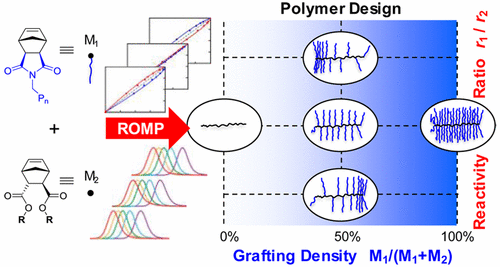当前位置:
X-MOL 学术
›
J. Am. Chem. Soc.
›
论文详情
Our official English website, www.x-mol.net, welcomes your
feedback! (Note: you will need to create a separate account there.)
Control of Grafting Density and Distribution in Graft Polymers by Living Ring-Opening Metathesis Copolymerization
Journal of the American Chemical Society ( IF 14.4 ) Pub Date : 2017-03-03 , DOI: 10.1021/jacs.7b00791 Tzu-Pin Lin 1 , Alice B. Chang 1 , Hsiang-Yun Chen 1 , Allegra L. Liberman-Martin 1 , Christopher M. Bates , Matthew J. Voegtle 2 , Christina A. Bauer 2 , Robert H. Grubbs 1
Journal of the American Chemical Society ( IF 14.4 ) Pub Date : 2017-03-03 , DOI: 10.1021/jacs.7b00791 Tzu-Pin Lin 1 , Alice B. Chang 1 , Hsiang-Yun Chen 1 , Allegra L. Liberman-Martin 1 , Christopher M. Bates , Matthew J. Voegtle 2 , Christina A. Bauer 2 , Robert H. Grubbs 1
Affiliation

|
Control over polymer sequence and architecture is crucial to both understanding structure-property relationships and designing functional materials. In pursuit of these goals, we developed a new synthetic approach that enables facile manipulation of the density and distribution of grafts in polymers via living ring-opening metathesis polymerization (ROMP). Discrete endo,exo-norbornenyl dialkylesters (dimethyl DME, diethyl DEE, di-n-butyl DBE) were strategically designed to copolymerize with a norbornene-functionalized polystyrene (PS), polylactide (PLA), or polydimethylsiloxane (PDMS) macromonomer mediated by the third-generation metathesis catalyst (G3). The small-molecule diesters act as diluents that increase the average distance between grafted side chains, generating polymers with variable grafting density. The grafting density (number of side chains/number of norbornene backbone repeats) could be straightforwardly controlled by the macromonomer/diluent feed ratio. To gain insight into the copolymer sequence and architecture, self-propagation and cross-propagation rate constants were determined according to a terminal copolymerization model. These kinetic analyses suggest that copolymerizing a macromonomer/diluent pair with evenly matched self-propagation rate constants favors randomly distributed side chains. As the disparity between macromonomer and diluent homopolymerization rates increases, the reactivity ratios depart from unity, leading to an increase in gradient tendency. To demonstrate the effectiveness of our method, an array of monodisperse polymers (PLAx-ran-DME1-x)n bearing variable grafting densities (x = 1.0, 0.75, 0.5, 0.25) and total backbone degrees of polymerization (n = 167, 133, 100, 67, 33) were synthesized. The approach disclosed in this work therefore constitutes a powerful strategy for the synthesis of polymers spanning the linear-to-bottlebrush regimes with controlled grafting density and side chain distribution, molecular attributes that dictate micro- and macroscopic properties.
中文翻译:

通过活性开环复分解共聚控制接枝聚合物的接枝密度和分布
对聚合物序列和结构的控制对于理解结构-性能关系和设计功能材料至关重要。为了实现这些目标,我们开发了一种新的合成方法,可以通过活性开环复分解聚合 (ROMP) 轻松控制聚合物中接枝物的密度和分布。离散的内、外-降冰片烯基二烷基酯(二甲基 DME、二乙基 DEE、二正丁基 DBE)被战略性地设计为与降冰片烯官能化聚苯乙烯 (PS)、聚丙交酯 (PLA) 或聚二甲基硅氧烷 (PDMS) 大分子单体共聚,由第三代复分解催化剂(G3)。小分子二酯充当稀释剂,增加接枝侧链之间的平均距离,生成具有不同接枝密度的聚合物。接枝密度(侧链数/降冰片烯主链重复数)可以通过大分子单体/稀释剂进料比直接控制。为了深入了解共聚物序列和结构,根据末端共聚模型确定了自传播和交叉传播速率常数。这些动力学分析表明,共聚具有均匀匹配的自传播速率常数的大单体/稀释剂对有利于随机分布的侧链。随着大分子单体和稀释剂均聚速率之间的差异增加,反应性比率偏离统一,导致梯度趋势增加。为了证明我们方法的有效性,一系列单分散聚合物 (PLAx-ran-DME1-x)n 具有可变接枝密度 (x = 1.0, 0.75, 0.5, 0. 25) 和总主链聚合度 (n = 167, 133, 100, 67, 33) 被合成。因此,这项工作中公开的方法构成了一种强有力的策略,用于合成跨越线性到瓶刷体系的聚合物,具有受控的接枝密度和侧链分布,分子属性决定了微观和宏观特性。
更新日期:2017-03-03
中文翻译:

通过活性开环复分解共聚控制接枝聚合物的接枝密度和分布
对聚合物序列和结构的控制对于理解结构-性能关系和设计功能材料至关重要。为了实现这些目标,我们开发了一种新的合成方法,可以通过活性开环复分解聚合 (ROMP) 轻松控制聚合物中接枝物的密度和分布。离散的内、外-降冰片烯基二烷基酯(二甲基 DME、二乙基 DEE、二正丁基 DBE)被战略性地设计为与降冰片烯官能化聚苯乙烯 (PS)、聚丙交酯 (PLA) 或聚二甲基硅氧烷 (PDMS) 大分子单体共聚,由第三代复分解催化剂(G3)。小分子二酯充当稀释剂,增加接枝侧链之间的平均距离,生成具有不同接枝密度的聚合物。接枝密度(侧链数/降冰片烯主链重复数)可以通过大分子单体/稀释剂进料比直接控制。为了深入了解共聚物序列和结构,根据末端共聚模型确定了自传播和交叉传播速率常数。这些动力学分析表明,共聚具有均匀匹配的自传播速率常数的大单体/稀释剂对有利于随机分布的侧链。随着大分子单体和稀释剂均聚速率之间的差异增加,反应性比率偏离统一,导致梯度趋势增加。为了证明我们方法的有效性,一系列单分散聚合物 (PLAx-ran-DME1-x)n 具有可变接枝密度 (x = 1.0, 0.75, 0.5, 0. 25) 和总主链聚合度 (n = 167, 133, 100, 67, 33) 被合成。因此,这项工作中公开的方法构成了一种强有力的策略,用于合成跨越线性到瓶刷体系的聚合物,具有受控的接枝密度和侧链分布,分子属性决定了微观和宏观特性。































 京公网安备 11010802027423号
京公网安备 11010802027423号